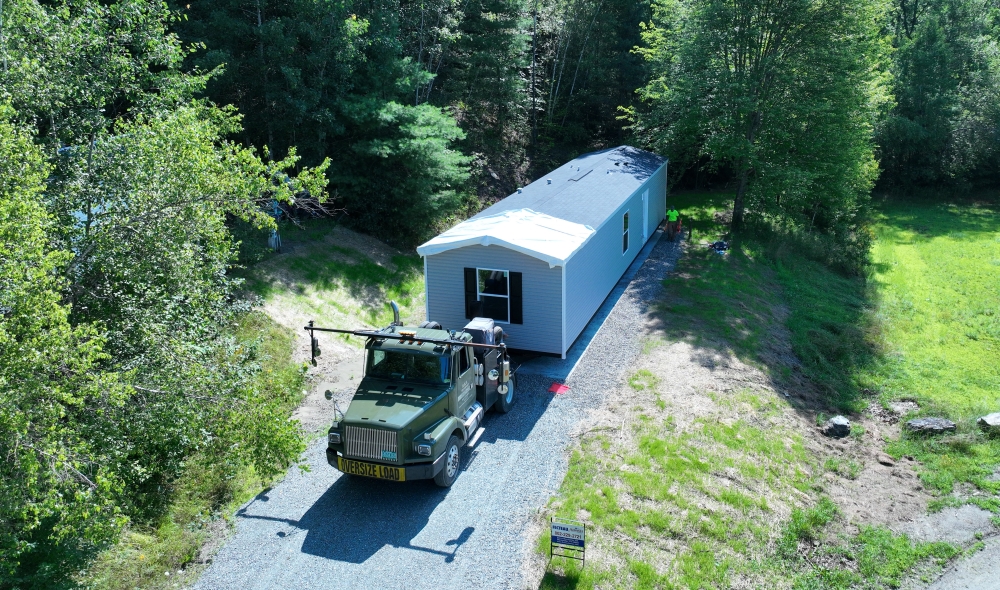
At VTrans, long-time employees Stacy Andre and Mike Booth are known as people who get stuff done.
So, when the Scott Administration needed a team to launch a new initiative helping flood victims and low- and middle-income Vermonters buy their own homes, they went straight to Stacy and Mike and asked them if they would take it on.
“I said yes, sure, because you’re helping Vermonters who don’t normally get help,” says Booth. “It would be great to be part of the solution, try to fix the problem.”
“I instantly said yes. We are in a housing crisis. How can I serve?” says Andre. “This is why I joined the state. I really enjoy being able to be part of a bigger, broader effort.”
Now the two are co-chairs of the Vermont Mobile Home Unit Task Team. They designed, and are now implementing, the Mobile Home Infill Program (MHIP). The program identifies vacant lots in private, nonprofit, and cooperative mobile home parks across Vermont, then makes site improvements, and purchases energy-efficient manufactured homes to sell to qualified Vermont buyers.
The Vermont State Housing Authority (VSHA) is an invaluable partner in this effort.
“This is our mission work,” explains Kathleen Berk, Vermont State Housing Authority Executive Director. “VSHA is the largest manager of mobile home park communities in the state of Vermont. We have the expertise to do this and do it well.”
As of November 1, flood-impacted Vermonters interested in buying a home can visit the MHIP website and register by filling out an Interest and Eligibility Form found by clicking on the Homebuyer Checklist icon. The MHIP website also features home listings by county, a sample Purchase and Sale Agreement, homebuyer education resources, and more about the timeline and next steps in the homebuying process. Starting November 15, all eligible Vermonters will be able to register for the program.
“This program enables first time homebuyers to get their foot in the door, making first time opportunities available when they need it most,” says Berk.
Regardless of when someone applies, they must meet two criteria:
- Be a Vermont resident
- Earn 120% or less of the Area Median Income in the county where they live now, not where they plan to buy a MHIP home.
Interested MHIP participants should also get a prequalification letter now from a lending institution based on their finances that establishes a range of how much they can spend on a home. This is different than obtaining a mortgage which comes later in the homebuying process. On the MHIP website you can also find a list of lenders with experience in the manufactured home space. Some offer down payment assistance, lower interest mortgage rates, and/or closing assistance.
The first 30 MHIP homes are expected to be ready for occupancy by the end of 2024. Current funding allows for an additional 70 to hit the market in 2025. To date, the MHIP Team has identified 57 lots at 12 manufactured home communities in Bennington, St. Johnsbury, Milton, Braintree, Coventry, Brattleboro, Westminster, Springfield, and Vergennes. There are eight different manufactured home models to choose from and a variety of floorplans.
“These are lovely homes,” says Andre. “They have hardwood laminate floors, soft close drawers, many have kitchen islands with USB ports, and modern finishes. All models come with brand-new energy rated appliances including a refrigerator, stove, microwave, and dishwasher. All units come with new energy star washers and dryers. So, we're really excited to bring these to market.”
The homes are sold at-cost, meaning no markup for buyers. That’s possible because VSHA uses the state’s buying power to purchase mobile homes in bulk. Homes that would normally retail for $130,000 to $160,000 can be bought by MHIP participants for $89,000 to $110,000.
“It’s unheard of to buy a new home for $100,000,” says Booth. “Today’s market you either spend $500,000 on a home or you spend $2,000 a month in rent, so this is going to help a lot of people.”
MHIP is also investing in site work and a new concrete pad before the home arrives, saving buyers up to $40,000 more.
MHIP is not possible without support from park owners. Participating manufactured home communities can be found on the MHIP website. They help identify vacant lots on their property and vet prospective buyers.
Unsworth Properties owns five parks in Vermont. James Unsworth is a fan of the program and hopes to add three MHIP homes to the River Bend Mobile Home Community Unsworth Properties owns in St. Johnsbury.
“This seems to me to be a no-brainer and a win-win for everybody,” says Unsworth. “We get improvements to our parks, we are filling vacant lots with qualified applicants, and it’s helping the state economy by keeping people in Vermont.”
And, Unsworth points out, adding more homes grows a municipality’s grand list increasing the tax base and the number of property taxpayers to help lessen the tax burden on everyone.
Vermont’s housing crunch has been growing for decades and recent flooding has only made the problem worse. There are simply not enough places to buy or rent across all price points and in every corner of Vermont. The state’s most recent Housing Needs Assessment finds Vermont needs to add 24,000 to 36,000 homes by 2029 just to meet current demand. In this environment, every new unit is a win.
“If we can provide homes for people who are ready to move into them, we could potentially open up apartments and get movement going within the housing sector,” says Andre.
“We’re very excited about this initiative,” says Berk. “We are hitting all of our benchmarks. We’re excited to prove that affordable housing can be done in a different way in Vermont.”
